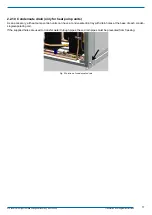
22
We reserve the right to make changes without any prior notice.
Translation from original instructions
3.3 Handling
Before each unit handling operation, check that the lifting capacity of the machinery used is compatible with the weight of
the unit.
Handling must be carried out by adequately equipped qualified personnel.
In all lifting operations, make sure the unit is firmly secured in order to prevent accidental falls or overtur
-
ning.
Lifting must be carried out by qualified and authorised personnel taking the necessary precautions; if
carried out incorrectly, lifting can cause serious damage and physical injury.
Do not, under any circumstances, stand or pass under or near the unit when it is lifted off the ground.
Use only the lifting system designed and prepared for the unit.
During unloading and positioning of the unit, great care must be taken to prevent sudden or violent manoeuvres, and the
components of the unit must not be used as lifting points.
Make sure the machinery and lifting ropes are of suitable size and capacity and strictly follow their operating instructions.
Use only equipment that is in excellent working order.
All work on the unit, including unpacking and connections, must be carried out with the unit resting on the ground.
Refer, in any case, to the lifting instructions provided with the unit.
The units are dispatched screwed onto pallets having anti-overturning boards. To unload them from the vehicle, use a forklift
truck or a crane.
If a forklift truck is used, insert the forks under the unit on the side where the anti-overturning boards are fixed, with the forks
as far apart as possible, until they protrude from the back of the base, and keep the centre of gravity of the unit centred
between the forks.
Fig. 4 Lifting with forklift truck
















































